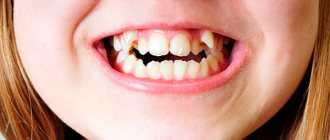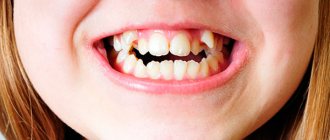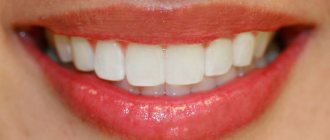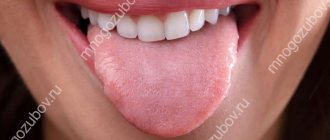Statistical studies based on the results of diagnostic procedures performed in clinical settings show that occlusal deviations occur in the majority of people. Quite often, patients are unaware of the presence of a problem, turning to orthodontists solely out of a desire to improve the aesthetics of their smile, but in fact, the pathological condition can provoke more serious consequences. The correct ratio of the upper and lower rows is characterized by close contact of the antagonists, a small (no more than a third of the height of the crowns) overlap, as well as a natural anatomical arrangement of the elements. Malocclusion, the types of which are classified based on characteristic symptoms, requires proper treatment.
Open bite
An overbite is called this way if, during central occlusion, the dentition, it is important to note, not the extreme ones, but the frontal ones, do not close. The cause is shortened central teeth and dentoalveolar long teeth on the sides. This bite can also be horizontal.
Externally it manifests itself in lengthening and tension of the face, increasing the length of the chin and lower section of the face. Usually there is no closure of the lips or closure is difficult and is given with effort. The gap between the teeth obscures the large tongue.
Treatment of malocclusion in children - modern methods
Parents need to understand that the defects in question do not go away on their own. To correct them, appropriate treatment is required under the supervision of an orthodontist. Today, functional orthodontics has a wide range of various corrective devices to solve various clinical problems.
On a note! For the youngest patients, experts offer special orthodontic pacifiers with beveled papillae. To grasp such a pacifier, the child has to push his upper jaw a little further, exactly the same as he does when grasping his mother’s breast. This pacifier promotes proper growth of the jaw apparatus, strengthening of the lower jaw, and correct formation of the temporomandibular joint.
Modern methods for correcting abnormalities of the jaw apparatus involve the use of various corrective structures. The most common devices include the following systems:
- plates - this type is usually used for children, including those with a milk bite. The device is a structure made of metal arches with a plastic base and a screw for correcting the force of pressure on the teeth,
- Trainers and aligners are elastic, removable aligners that have special recesses in their design for each tooth. The full course involves the step-by-step use of different variations of mouthguards, included in one set and designed for different periods of treatment,
- Braces are the best option for teenagers and adults. A non-removable device, which is usually installed for a period of six months to several years, depending on the severity of the pathology. This is a more complex design that includes an arch, plates that are attached directly to the teeth, as well as fastening elements in the form of locks or ligatures - elastic bands. In this case, braces can be made of metal, plastic, ceramics and even sapphire. According to patient reviews, the best and fastest treatment option for the child would be to install a standard metal model. The choice of one model or another directly depends on the defects present and the financial capabilities of the patients.
In addition to the devices listed above, additional components such as face masks, arches and blocks are widely used in orthodontic practice. They can be used not only as auxiliary elements, but also as independent devices.
Deep bite
Expressed in the relative position of the lower and upper jaw rows along the anterior segment so that the upper teeth protrude in front of the lower ones by at least a third of the length of the crowns of the latter. During anterior occlusion, the cutting parts of the lower anterior incisors pass the dental cusps of the upper anterior teeth and touch their palatal parts at the base.
The most advanced forms manifest themselves painfully - the lower central incisors come into contact with the mucous membrane of the palate and, as a result, damage it (this is the degree of deep and traumatic interaction).
What is the importance of orthodontic treatment for children?
Some parents believe that baby teeth do not need any treatment or correction of their position. Why put your child through additional stress if the temporary teeth are going to fall out anyway? This is a deep misconception, due to which the health of the permanent dentition often suffers. If a child has had certain anomalies in the structure of the jaw apparatus and the position of the teeth since childhood, treatment should be started immediately. Age plays an important role in orthodontics and bite correction, because it is in childhood that bones are more plastic, due to which correction is easier and much faster.
The importance of orthodontic treatment in childhood is due to the following reasons:
- timely correction will help prevent many problems with teeth and the child’s health in general,
- at an early age, correction of defects takes much less time, while for an adult, treatment of similar anomalies requires twice as much time, despite the fact that the guarantees of the result will be very vague,
- The specialist gets the opportunity to control the direction of growth and the process of tooth formation, and make the necessary adjustments in a timely manner.
If you notice that your child’s teeth are overlapping each other or, for example, one of the jaws is protruding forward, be sure to make an appointment with the orthodontist. After a visual examination, the specialist will be able to identify a specific problem, assess its severity and prescribe timely treatment.
Crossbite
Characterized by atypical (reverse) closure of the anterior or lateral or both the first and second teeth together with simultaneous deviation of closure in the left or right area of the bite. A double form of this bite is possible.
If professional treatment and care are not provided, patients with transverse bite experience facial distortions and serious changes in appearance, as the jaw bones develop asymmetrically. Characterized by chewing dysfunction and difficulties with pronunciation. Often patients with this bite suffer from biting the mucous membranes of the cheeks, tongue, and lips.
Possible consequences
Malocclusion is a cosmetic defect; a person with a violation of the position of the teeth may experience psychological discomfort and embarrassment, and difficulties with communication. In addition, it can cause facial asymmetry and changes in a person’s profile.
However, psycho-emotional consequences are not all that can be fraught with the pathology of the development of the dental system. Bite defects affect your health as follows:
- there is a risk of developing periodontal diseases (periodontitis, periodontal disease);
- there is a high probability of inflammation of the soft tissues of the oral cavity - this is associated with the risk of injury from the edges of incorrectly positioned teeth;
- the incidence of caries increases - a broken bite makes hygiene difficult, a large amount of plaque and tartar are formed, caries occurs;
- tooth decay may be non-carious, improper distribution of the chewing load leads to increased abrasion of the enamel of certain groups of teeth, a high risk of chips and cracks due to mechanical loads;
- diseases of the gastrointestinal tract develop due to poor quality of chewing food;
- speech defects, speech therapy problems occur, sound pronunciation is disrupted;
- diseases of the temporomandibular joint are formed;
- Chronic headaches occur due to impaired tone of the masticatory muscles due to improper, uneven distribution of the load.
That is why the main indication for correcting malocclusion is taking care of your health, although the aesthetics of a smile cannot be discounted.
Reasons for the formation of pathology
There may be several components that provoke the formation of pathology.
Internal:
- Provided that the child’s parents are diagnosed with an incorrect bite relationship of the jaws; teeth with non-standard anatomy, size or location - with a high probability the pathology will be inherited.
- Disorders of intrauterine fetal formation, diseases of women during pregnancy (anemia, intrauterine infections), trauma during childbirth.
External:
- Failure to comply with the rules of natural and artificial feeding by parents in infants is fraught with the formation of pathological closure of the HF and LF. The hole in the nipple should be small so that the baby can perform chewing and sucking manipulations.
- It is important to pay attention to bad habits at home, because psychosomatics are involved. Make sure that when sleeping on the side the child does not place his hand under his cheek - there may be a danger of developing a unilateral defect. Tension in your sleeping position can also interfere with the smooth development of your mouth. A child’s harmful habit of constantly sucking a finger, pacifier, and other objects threatens to form a malocclusion.
- It is necessary to monitor the nutritional balance in children at any age. It is important to maintain optimal amounts of fluoride, calcium and other minerals in the body. If you determine a violation of their metabolism, contact your pediatrician.
- Poor posture in a teenager, when the head goes forward and the back goes back, leads to a greater development of high frequency than low frequency.
- Problems with nasal breathing, together with ENT pathologies, lead to pathologies in the formation of the jaws.
- It is important to promptly treat caries and maxillofacial pathology, restore early loss of milk units; Avoid injury, fractures, and prosthetic errors.
- You should pay attention and monitor the formation of the rudiments of wisdom teeth (eights), remove them in time to prevent displacement of the dental units.
Causes of malocclusion
All such anomalies arise due to the interaction of various factors, which are conventionally divided into two groups:
- genetic. These include inheritance of a non-standard bite or developmental features of the jaw bones of the parents;
- external. This includes:
- maternal diseases (before and during pregnancy);
- various pathologies of intrauterine development;
- complications and injuries during childbirth;
- incorrect feeding technology;
- otolaryngological diseases suffered in early childhood;
- habit of breathing through the mouth;
- incorrect position in sleep;
- rickets;
- uneven wear of primary teeth;
- bad habits in childhood (biting fingers);
- incorrect posture;
- late or too early replacement of baby teeth;
- eating disorders;
- damage to the musculoskeletal system and oral organs.
How much will the treatment cost?
As for the prices for orthodontic treatment, it all depends on the chosen method, the system used, as well as the degree of complexity of the anomaly, which, in turn, determines the duration of the course. For example, treatment using a set of aligners designed for a year can cost the patient a tidy sum of 180 to 300 thousand rubles. In the case of braces, the exact cost will depend on the type and brand of the device.
The most expensive are lingual systems (plates are located on the inside of the dentition), as well as sapphire and ceramic - here the price tag varies from 100 to 250 thousand rubles for a lingual model (prices are for installing braces on one jaw, a one-year turnkey course) . Removable plates, which are indicated for correcting malocclusion specifically in childhood, will cost much less - from 6 to 25 thousand for an expanding model (for one jaw). The price will also be directly influenced by the level of prestige of the dental center whose services you decide to use.
How to understand when it’s time to see a pediatric orthodontist
There are many factors that can affect the growth and formation of the dentofacial apparatus: genetics, the habit of chewing the tip of a pencil or sucking a thumb, mouth breathing, past illnesses, injuries and much more. But how do you know when it’s time to show your child to a specialist? First, you need to visually assess how smoothly the teeth grow, whether there are too large gaps between them, and whether the jaws close correctly. Also, experts in the field of orthodontics advise paying attention to the following points:
- bad habits: if a child sucks his thumb or bites a pillow in his sleep, if while writing he unconsciously pulls the tip of a pencil or pen into his mouth - all this is a reason to show the baby to an orthodontist. Such habits very quickly lead to changes in the bite and position of the teeth,
- mouth breathing: when a child breathes through his mouth most of the time, the jaws remain open for a long time, which has a direct impact on the correctness of their formation,
- Difficulty chewing food: You can notice this symptom if you carefully observe how the baby eats. Incorrect positioning of the chewing teeth often leads to the fact that the child has to use the neck muscles while chewing,
- Grinding of teeth during sleep: incorrect development of the jaw apparatus is often accompanied by nocturnal grinding of teeth.
Unfortunately, in orthodontic practice there are cases when hardware treatment alone is not enough. Sometimes, to correct anomalies, the doctor has to resort to surgery, namely the removal of individual teeth. In such a situation, further treatment will involve prosthetics - restoring the integrity of the dentition with the help of crowns and dentures. In order not to start the problem and not bring it to a critical state, parents need to carefully monitor their children’s teeth and the health of the child’s oral cavity, how correctly their dental system is formed.
Orthodontic diagnostic process
Before correcting the bite, the orthodontist organizes a step-by-step diagnosis:
- conducts an examination of the oral cavity;
- Visiographic photographs are taken;
- takes impressions and makes diagnostic models;
- takes a photo of the patient’s teeth, face and smile (determines the appearance, symmetry of the face or the influence of identified bite pathologies on these factors).
Bite in the absence of teeth
It’s interesting, but even if you have no teeth at all, there is no guarantee that with prosthetics you will be able to create the right jaw . It all depends on how damaged the dental system was before removing all its elements. If the jaws are within normal limits relative to each other, the doctor will be able to make adjustments to the prosthesis. If there are also problems with the bones, more complex methods of restoring the dentition will be necessary.
In the absence of teeth, the bite in people is determined using special wax rollers that are placed in the mouth and allow measurements to be taken. The instruments used are a ruler arc and an intraoral plate. Next, a plaster and then a regular prosthesis is created.
Occlusion form
The shape of the bite can be determined by knowing the size and height of each individual tooth. During the measurement, both jaws should be in a state of complete rest. This is a condition when the lower jaw is as close to the upper jaw as naturally as possible. Only such an arrangement will make it possible to obtain accurate measurement results. A normal distance is considered to be 2-5 mm.
The height of the bite is the localization of parts of the dentition, and its size is the main factor in the normal position of the teeth. Thus, its incorrect height is one of the main signs of disorders in the structure of the jaws.
In addition to special methods, height is determined even by ordinary observation, but correct measurement can only be done by a highly qualified orthodontist with many years of experience.
Methods for correcting bites at the SDent clinic
After a detailed diagnosis and diagnosis, the doctor determines a method for correcting malocclusion in a child or adult. Within the walls of our clinic, the tactics for correcting the bite are chosen based on the clinical picture, the characteristics of the patient’s body, the capabilities and wishes of the patient.
- Plates
This type of orthodontic structure does not require constant wearing; it can be removed in case of discomfort or before meals. The removable plastic structure includes several metal elements. The orthodontist himself adjusts the hooks and springs on the plate, which allows you to move the teeth in the right direction. The method is effective in correcting minor malocclusions in children and adults.
- Trainers
Removable products are made of transparent silicone. At the initial stage of treatment, elastic structures are used, at the final stage - solid structures. Children's and adult orthodontics does not exclude the use of mouthguards to correct bites, as well as to normalize nasal breathing, correct imperfections in diction, and get rid of bad habits. The advantage of the devices is that they need to be used at night. During the day, it is enough to put on the trainers for 2-4 hours.
- Aligners
We are talking about removable appliances that are fixed to the elements of the dentition and worn at least 22 hours a day. Remove the product only when eating and performing hygienic procedures. The technique is especially effective for crowded teeth, narrow or wide arches, and if it is necessary to correct a relapse. You should visit your doctor every 20 days to replace your mouth guards.
- Veneers (Lumineers)
Veneers are called microprostheses in the form of thin plates. They are attached to the outer side of the dentition - the onlays help to “correct” the more aesthetic side of the smile. With the help of veneers, small irregularities in the dentition are hidden when other methods are not applicable for some reason. If serious pathology needs to be corrected, veneers are not effective.
- Braces for correcting defects
When it is not possible to correct the bite with removable appliances, braces come to the rescue. The system consists of many tiny locks and a metal arch, which is fixed in the grooves of plates attached to the surface of the tooth. In addition, orthodontic structures are equipped with springs, chains, and rings. All the “power” of braces is in the arch, which is responsible for “memory”: placed on the teeth, it always tries to return to its original position. Over time, she manages to “pull” the teeth along with her, placing them in the right place. When initially correcting a defect, elastic systems are used, which after a while are replaced with hard braces.
There are many types of braces systems. Depending on the location, the following are distinguished:
- vestibular - fixed to the outer surface of the dentition, noticeable on the teeth;
- lingual - attached from the side of the tongue, aesthetic. The main difference from vestibular braces is that they are not noticeable to others.
An alternative criterion for classifying structures is the method of fastening the brackets in a metal arch. The traditional option is ligature products, in which the key role is played by ligatures or elastic rings. Such devices are affordable in price and allow you to cope with serious bite pathologies.
Ligature-free braces are not as bulky. The arc is secured in the grooves of the system using special locks. Unlike its predecessor, the arc of the system is not fixed so rigidly - the process of correcting the pathology is relatively painless.
The cost of correcting dental malocclusion in our dental clinic is largely determined by the material from which the braces are made:
- metal - the most inexpensive ligature and non-ligature devices. Their advantageous characteristics are strength, the ability to demonstrate an operative therapeutic result;
- plastic - the most affordable option for transparent products. They are not as strong as metal ones, but they are invisible on the teeth;
- ceramic – braces made of polycrystalline ceramics. The structures are selected to match the color of the enamel coating; they are durable and attractive in appearance, but require careful handling, since they are quite fragile;
- sapphire – the most expensive of the presented braces. The systems are transparent and look aesthetically pleasing.
The choice of a specific system should be made based on the characteristics of the clinical case. In addition, it is worth indicating how much money you are willing to spend on orthodontic teeth straightening, voice the parameters that are most important when correcting the bite (aesthetics, price, etc.).











